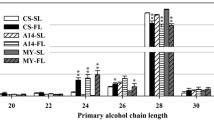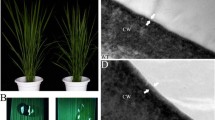Abstract
In plants, extracellular matrix polymers built from polysaccharides and cuticular lipids have structural and protective functions. The cuticle is found to be ten times thinner in Arabidopsis thaliana (L.) Heynh than in many other plants, and there is evidence that it is unusual in having a high content of α-,ω-dicarboxylic fatty acids (FAs) in its polyesters. We designated the new organ fusion mutant hth-12 after it appeared to be allelic to adhesion of calyx edges (ace) and hothead (hth), upon molecular cloning of the gene by transposon tagging. This mutant is deficient in its ability to oxidize long-chain ω-hydroxy FAs to ω-oxo FAs, which results in leaf polyesters in decreased α-,ω-dicarboxylic FAs and increased ω-hydroxy FAs. These chemical phenotypes lead to disorder of the cuticle membrane structure in hth-12. ACE/HTH is a single-domain protein showing sequence similarity to long-chain FA ω-alcohol dehydrogenases from Candida species, and we hypothesize that it may catalyze the next step after cytochrome P450 FA ω-hydroxylases in the ω-oxidation pathway. We show that ACE/HTH is specifically expressed in epidermal cells. It appears very likely therefore that the changes in the amount of α-,ω-dicarboxylic FAs in hth-12 reflect the different composition of cuticular polyesters. The ACE/HTH gene is also expressed in root epidermal cells which do not form a polyester membrane on the exterior surface, thereby making it possible that the end products of the pathway, α-,ω-dicarboxylic FAs, are generally required for the cross-linking that ensures the integrity of the outer epidermal cell wall.







Similar content being viewed by others
Abbreviations
- GC–MS:
-
Gas chromatography–mass spectrometry
- RT-PCR:
-
Reverse transcription-polymerase chain reaction
- SEM:
-
Scanning electron microscopy
- TEM:
-
Transmission electron microscopy
- WT:
-
Wild type
References
Aharoni A, Dixit S, Jetter R, Thoenes E, van Arkel G, Pereira A (2004) The SHINE clade of AP2 domain transcription factors activates wax biosynthesis, alters cuticle properties, and confers drought tolerance when overexpressed in Arabidopsis. Plant Cell 16:2463–2480
Agrawal VP, Kolattukudy PE (1977) Biochemistry of suberization: ω-hydroxyacid oxidation in enzyme preparations from suberizing potato tuber disks. Plant Physiol 59:667–672
Andrews J, Adams SR, Burton KS, Evered EC (2002) Subcellular localization of peroxidase in tomato fruit skin and the possible implications for the regulation of fruit growth. J Exp Bot 53:2175–2191
Araki T, Nakatani-Goto M (1999) Arabidopsis ADHESION OF CALYX EDGES (ACE), genomic. Published only in DataBase
Baud S, Bellec Y, Miquel M, Bellini C, Caboche M, Lepiniec L, Faure J-D, Rochat C (2004) gurke and pasticcino3 mutants affected in embryo development are impaired in acetyl-CoA carboxylase. EMBO Rep 5:515–520
Bellec Y, Harrar Y, Butaeye C, Darnet S, Bellini C, Faure J-D (2002) PASTICCINO2 is a protein tyrosine phosphatase-like involved in cell proliferation and differentiation in Arabidopsis. Plant J 32:713–722
Bonaventure G, Beisson F, Ohlrogge J, Pollard M (2004) Analysis of the aliphatic monomer composition of polyesters associated with Arabidopsis epidermis: occurrence of octadeca-cis-6, cis-9-diene-1,18-dioate as the major component. Plant J 40:920–930
Branen JK, Chiou T-J, Engeseth NJ (2001) Overexpression of acyl carrier protein-1 alters fatty acid composition of leaf tissue in Arabidopsis. Plant Physiol 127:222–229
Broun P, Poindexter P, Osborne E, Jiang C-Z, Riechmann JL (2004) WIN1, a transcriptional activator of epidermal wax accumulation in Arabidopsis. Proc Natl Acad Sci USA 101:4706–4711
Browse J, McCourt PJ, Somerville CR (1986) Fatty acid composition of leaf lipids determined after combined digestion and fatty acid methyl ester formation from fresh tissue. Anal Biochem 152:141–145
Chen X, Goodwin SM, Boroff VL, Liu X, Jenks MA (2003) Cloning and characterization of the WAX2 gene of Arabidopsis involved in cuticle membrane and wax production. Plant Cell 15:1170–1185
Cheng Q, Liu H-T, Bombelli P, Smith A, Slabas AR (2004) Functional identification of AtFao3, a membrane bound long chain alcohol oxidase in Arabidopsis thaliana. FEBS Lett 574:62–68
Dreveny I, Gruber K, Glieder A, Thompson A, Kratky C (2001) The hydroxynitrile lyase from almond: a lyase that looks like an oxidoreductase. Structure 9:803–815
Efremova N, Schreiber L, Bär S, Heidmann I, Huijser P, Wellesen K, Schwarz-Sommer Z, Saedler H, Yephremov A (2004) Functional conservation and maintenance of expression pattern of FIDDLEHEAD-like genes in Arabidopsis and Antirrhinum. Plant Mol Biol 56:821–837
Franke R, Briesen I, Wojciechowski T, Faust A, Yephremov A, Nawrath C, Schreiber L (2005) Apoplastic polyesters in Arabidopsis surface tissues—a typical suberin and a particular cutin. Phytochemistry 66:2643–2658
Haberer G, Erschadi S, Torres-Ruiz RA (2002) The Arabidopsis gene PEPINO/PASTICCINO2 is required for proliferation control of meristematic and non-meristematic cells and encodes a putative anti-phosphatase. Dev Genes Evol 212:542–550
Holmquist B, Vallee BL (1991) Human liver class III alcohol and glutathione dependent formaldehyde dehydrogenase are the same enzyme. Biochem Biophys Res Commun 178:1371–1377
Kolattukudy PE (2001a) Cutin from plants. In: Doi Y, Steinbuechel A (eds) Biopolymers: polyesters I—biological systems and biotechnological production, vol. 3a. Wiley, Muenster, Germany, pp. 1–35
Kolattukudy PE (2001b) Polyesters in higher plants. In: Babel W, Steinbuechel A (eds) Advances in biochemical engineering biotechnology. Biopolyesters, vol. 71. Springer, Berlin Heidelberg New York, pp. 1–49
Kolattukudy PE (2001c) Suberin from plants. In: Doi Y, Steinbuechel A (eds) Biopolymers: polyesters I—biological systems and biotechnological production, vol. 3a. Wiley, Muenster, Germany, pp. 41–68
Krolikowski KA, Victor JL, Wagler TN, Lolle SJ, Pruitt RE (2003) Isolation and characterization of the Arabidopsis organ fusion gene HOTHEAD. Plant J 35:501–511
Kurata T, Kawabata-Awai C, Sakuradani E, Shimizu S, Okada K, Wada T (2003) The YORE–YORE gene regulates multiple aspects of epidermal cell differentiation in Arabidopsis. Plant J 36:55–66
Le Bouquin R, Skrabs M, Kahn R, Benveniste I, Salaün JP, Schreiber L, Durst F, Pinot F (2001) CYP94A5, a new cytochrome P450 from Nicotiana tabacum is able to catalyze the oxidation of fatty acids to the ω-alcohol and to the corresponding diacid. Eur J Biochem 268:3083–3090
Lolle SJ, Cheung AY, Sussex IM (1992) Fiddlehead: an Arabidopsis mutant constitutively expressing an organ fusion program that involves interactions between epidermal cells. Dev Biol 152:383–392
Lolle SJ, Hsu W, Pruitt RE (1998) Genetic analysis of organ fusion in Arabidopsis thaliana. Genetics 149:607–619
Lolle SJ, Victor JL, Young JM, Pruitt RE (2005) Genome-wide non-mendelian inheritance of extra-genomic information in Arabidopsis. Nature 434:505–509
Nawrath C (2002) The biopolymers cutin and suberin. In: Somerville C, Meyerowitz E (eds) The Arabidopsis book. American Society of Plant Biologists, Rockville
Pruitt RE, Vielle-Calzada JP, Ploense SE, Grossniklaus U, Lolle SJ (2000) FIDDLEHEAD, a gene required to suppress epidermal cell interactions in Arabidopsis, encodes a putative lipid biosynthetic enzyme. Proc Natl Acad Sci USA 97:1311–1316
Schnurr J, Shockey J, Browse J (2004) The Acyl-CoA synthetase encoded by LACS2 is essential for normal cuticle development in Arabidopsis. Plant Cell 16:629–642
Schreiber L, Hartmann K, Skrabs M, Zeier J (1999) Apoplastic barriers in roots: chemical composition of endodermal and hypodermal cell walls. J Exp Bot 50:1267–1280
Sieber P, Schorderet M, Ryser U, Buchala A, Kolattukudy PE, Métraux J-P, Nawrath C (2000) Transgenic Arabidopsis plants expressing a fungal cutinase show alterations in the structure and properties of the cuticle and postgenital organ fusions. Plant Cell 12:721–737
Sinha N, Lynch M (1998) Fused organs in the adherent 1 mutation in maize show altered epidermal walls with no perturbations in tissue identities. Planta 206:184–195
Sorensen A-M, Krober S, Unte US, Huijser P, Dekker K, Saedler H (2003) The Arabidopsis ABORTED MICROSPORES (AMS) gene encodes a MYC class transcription factor. Plant J 33:413–423
Steiner-Lange S, Gremse M, Kuckenberg M, Nissing E, Schaechtele D, Spenrath N, Wolff M, Saedler H, Dekker K (2001) Efficient identification of Arabidopsis knock-out mutants using DNA-arrays of transposon flanking sequences. Plant Biol 3:391–397
Tanaka H, Onouchi H, Kondo M, Hara-Nishimura I, Nishimura M, Machida C, Machida Y (2001) A subtilisin-like serine protease is required for epidermal surface formation in Arabidopsis embryos and juvenile plants. Development 128:4681–4689
Tanaka H, Watanabe M, Watanabe D, Tanaka T, Machida C, Machida Y (2002) ACR4, a putative receptor kinase gene of Arabidopsis thaliana, that is expressed in the outer cell layers of embryos and plants, is involved in proper embryogenesis. Plant Cell Physiol 43:419–428
Tanaka T, Tanaka H, Machida C, Watanabe M, Machida Y (2004) A new method for rapid visualization of defects in leaf cuticle reveals five intrinsic patterns of surface defects in Arabidopsis. Plant J 37:139–146
Vanhanen S, West M, Kroon JTM, Lindner Nl, Casey J, Cheng Q, Elborough KM, Slabas AR (2000) A consensus sequence for long-chain fatty-acid alcohol oxidases from Candida identifies a family of genes involved in lipid omega-oxidation in yeast with homologues in plants and bacteria. J Biol Chem 275:4445–4452
Watanabe M, Tanaka H, Watanabe D, Machida C, Machida Y (2004) The ACR4 receptor-like kinase is required for surface formation of epidermis-related tissues in Arabidopsis thaliana. Plant J 39:298–308
Wellesen K, Durst F, Pinot F, Benveniste I, Nettesheim K, Wisman E, Steiner-Lange S, Saedler H, Yephremov A (2001) Functional analysis of the LACERATA gene of Arabidopsis provides evidence for different roles of fatty acid ω-hydroxylation in development. Proc Natl Acad Sci USA 98:9694–9699
Williamson RE, Burn JE, Hocart CH (2001) Cellulose synthesis: mutational analysis and genomic perspectives using Arabidopsis thaliana. Cell Mol Life Sci 58:1475–1490
Wisman E, Cardon GH, Fransz P, Saedler H (1998) The behaviour of the autonomous maize transposable element En/Spm in Arabidopsis thaliana allows efficient mutagenesis. Plant Mol Biol 37:989–999
Xiao F, Goodwin MS, Xiao Y, Sun Z, Baker D, Tang X, Jenks MA, Zhou J-M (2004) Arabidopsis CYP86A2 represses Pseudomonas syringae type III genes and is required for cuticle development. EMBO J 23:2903–2913
Yephremov A, Saedler H (2000) Display and isolation of transposon-flanking sequences starting from genomic DNA or RNA. Plant J 21:495–505
Yephremov A, Schreiber L (2005) The dark side of the cell wall: molecular genetics of plant cuticle. Plant Biosyst 139:74–79
Yephremov A, Wisman E, Huijser P, Huijser C, Wellesen K, Saedler H (1999) Characterization of the FIDDLEHEAD gene reveals a link between adhesion response and cell differentiation in the epidermis. Plant Cell 11:2187–2201
Yephremov A, Faust A, Kurdyukov S, Trenkamp S, Nawrath C, Franke R, Wojciechowski T, Efremova N, Voisin D, Toro F, Tietjen K, Schreiber L, Saedler H (2004) Safeguarding the cuticular wall. In: Xth cell wall meeting, Sorrento, 29 August–3 September 2004, Italy, p. 99
Acknowledgments
Sergey Kurdyukov and Andrea Faust contributed equally to this work. We thank Elmon Schmelzer and Rolf-Dieter Hirtz for helping us with microscopy, Aldona Ratajek-Kuhn for taking care of our plants, and RIKEN for providing cDNA clones for our study. We especially appreciate the criticisms of the manuscript made by Paul Hardy, Paul Schulze-Lefert, Michel Caboche, Christiane Nawrath, and Seth Davis. This work has been supported by a MPG fellowship to S.K., a DFG research grant to L.S., and a Bayer CropScience grant to A.Y.
Author information
Authors and Affiliations
Corresponding author
Rights and permissions
About this article
Cite this article
Kurdyukov, S., Faust, A., Trenkamp, S. et al. Genetic and biochemical evidence for involvement of HOTHEAD in the biosynthesis of long-chain α-,ω-dicarboxylic fatty acids and formation of extracellular matrix. Planta 224, 315–329 (2006). https://doi.org/10.1007/s00425-005-0215-7
Received:
Accepted:
Published:
Issue Date:
DOI: https://doi.org/10.1007/s00425-005-0215-7




